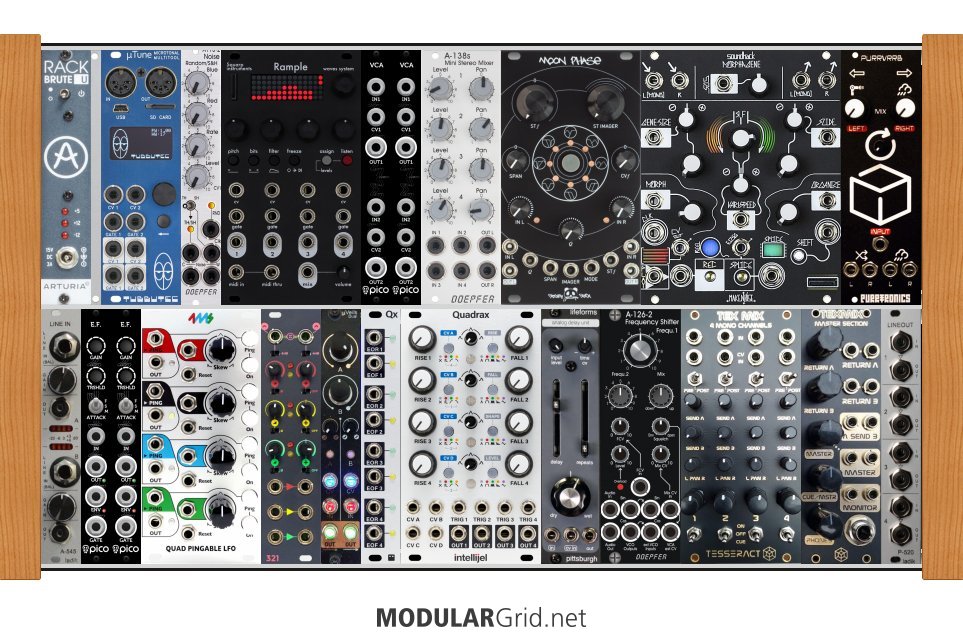Did a fill-out of this, minus the Subby. Now THIS is a decent 6U rig...

OK, what happened here? Some of the larger modules were downsized in order to get more functionality into the rig. However, if you take a close look, pretty much all of the original functions are there, along with a few tweaks.
TOP: There's a 1 hp spacer between the P/S and the MIDI interface. This is to get a tad more distance between the P/S and the rest of the top row, but moreso to provide a little bit more airflow to keep the P/S temp down a little. After that is the Tubbutech MIDI interface, then a Doepfer noise/sample and hold. The Rample follows that, then there's four VCAs and a Doepfer Mini Stereo Mixer. This is set up like this so that you can have basic VCA level control over the Rampler channels, then you can do your final level tweaks and panning (yep...I set it up for stereo output!) on the mixer before the audio hits the stereo VCF. And in this case, I opted for a very cool Patching Panda one that has several filter topologies...and, of course, a stereo thruput. Then this signal path ends at the Morphagene...but after that is one of Purrtronics' spring emulators, the Purrvrrb. This has a mono input and stereo outs, and we'll see why that's important in a bit...
BOTTOM: A Ladik dual line input (with metering and individual level controls) feeds a pair of Erica envelope followers. This way, you can not only inject a stereo signal into the modular, but you can also use the signal thru the EFs to provide modulation extracted from the incoming amplitude curves. LFOs are dealt with with a 4ms QPLFO, which is a quad LFO that has cycle times that range from the low end of audio down to 71 minutes...plus, you can 'ping' these with a trigger to reset the cycle AND to define new LFO times. After that is a fave modulation scrambler, Frap's 321, which I paired with an After Later dual VCA, which is a clone of 1/2 of a Veils so that you can amplitude-control your modulation signals. Then there's the Quadrax and the Qx expander. Remember that bit about the 'pings' for the QPLFO? The Qx sends end-of-rise and end-of-fall triggers based on the Quadrax's activity, and those triggers can be fed to the "ping" input on the QPLFO for LFO cycle resets or new timing values. But you can also turn the Qx on itself and this makes the Quadrax function in "cascade" fashion. For example, let's say you want a new envelope to start when another peaks...all you'd do is to send the EOR from one section to the next EG trigger. Send an EOR from that back to the first EG, and then you've got the two of them pinging off of each other. Quite nuts, really...and VERY useful.
Your mono effects are next. I swapped out the Erica bucket-brigade for a smaller Pittsburgh one, then the Frequency Shifter is after that. And then we're into the final mix/output, where I put in a Tesseract TexMix setup with four mono ins (sort of...vide infra) that all have VCA control, but you get panning, dual AUX sends, and a CUE switch available on all of those so that you can flip an input to CUE to check tuning or other on-the-fly stuff. And the MASTER section of this gives you your main fader, plus two stereo AUX returns. Now, remember what I mentioned about that Purrtronics reverb? The TexMix is set up to deal with that quite nicely, with two mono AUX sends and a pair of stereo AUX returns...BUT...you can also use a stereo AUX return to inject another stereo synth-level signal for a final total of 6 ins. The MASTER also has your headphone amp. Then at the end, there's a quad level shifter from synth to line level, as requested.
Now THIS is a serious rig. True, it's still got some space limitations, but I think I've managed to show here where this COULD go with the Subharmonicon removal and a few additional pokes at the original module complement.

